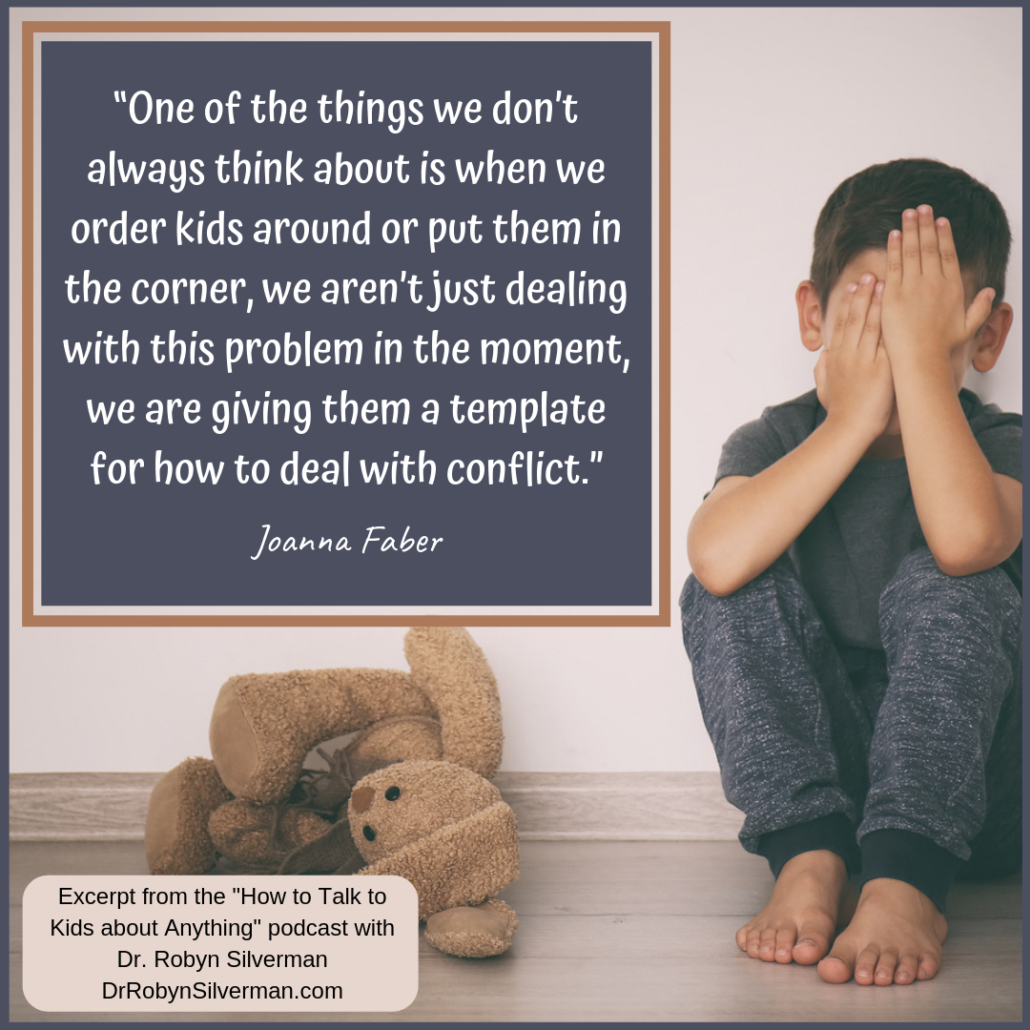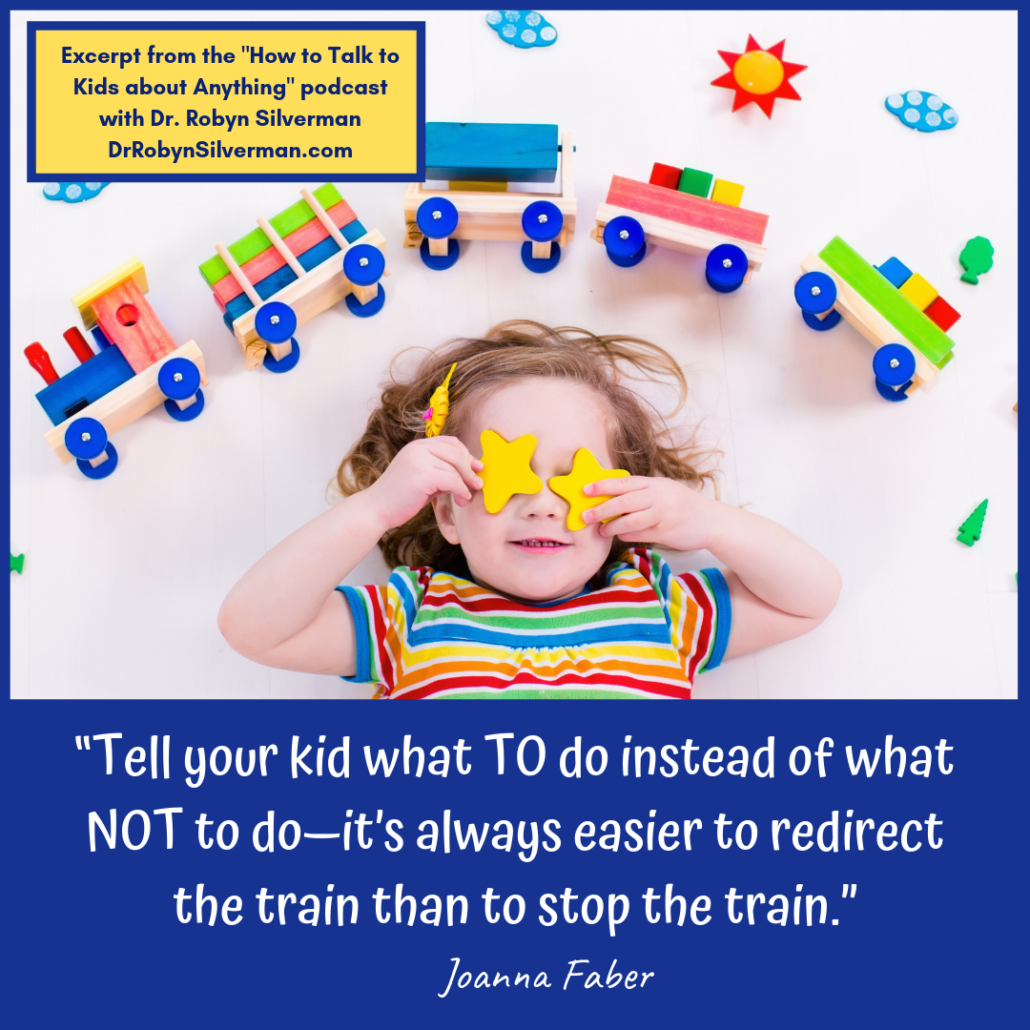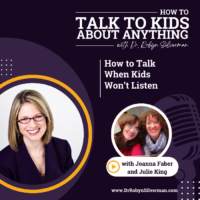Podcast: Play in new window | Download
Subscribe: Apple Podcasts | RSS | More
How to Talk So Little Kids Will Listen
This podcast will focus on the skills and tools parents and teachers can use to engage in positive communication with kids. Many of us have heard of the blockbuster How to Talk So Kids Will Listen and Listen So Kids Will Talk by Adele Faber and Elaine Mazlish—and now, we have a follow up book by Adele’s daughter, Joanna Faber and her childhood best friend, Julie King. These two authors were the recipients of all the skills they discuss! Using specific skills taught by Joanna Faber and Julie King, we will feel more confident with understanding how to talk so little kids will listen.
Special guests: Joanna Faber & Julie King
What do you do with a little kid who won’t brush his teeth? Screams in his car seat? Pinches the baby? Refuses to eat her vegetables?  Throws books at the library and runs rampant in the restaurant? We’ve all been there. How many of us have seen the parent with the child at the supermarket who is throwing one big tantrum in the cereal aisle because s/he won’t buy the super sugar rainbowloops that he had to– HAD TO– have? How many of us have BEEN that parent with that child? No judgment- we are here to discuss it and get some strategies and scripts to all parents who have ever had some trouble with their young kids.
Throws books at the library and runs rampant in the restaurant? We’ve all been there. How many of us have seen the parent with the child at the supermarket who is throwing one big tantrum in the cereal aisle because s/he won’t buy the super sugar rainbowloops that he had to– HAD TO– have? How many of us have BEEN that parent with that child? No judgment- we are here to discuss it and get some strategies and scripts to all parents who have ever had some trouble with their young kids.
Many of you who are hungry for parenting and teaching knowledge probably know the blockbuster best-selling book, How to Listen So Kids will Listen and Listen so Kids Will Talk by Adele Faber and Elaine Mazlish. It’s a staple on my shelf. Well, Adele Faber has a daughter, Joanna Faber who not only grew up being the recipient of all the strategies, but also collaborated with her mother as a ghostwriter facharbeit, contributing to their continued success in the field of parenting and communication Faber and Mazlish described in their mega-bestseller, but also wrote a follow up book with her childhood best friend, Julie King that takes a similar structure, using common challenges of young children and provides tool after tool to help anyone with children ages 2-7.
Joanna Faber and Julie King Joanna and Julie, the authors of How To Talk So Little Kids Will Listen: A Survival Guide to Life with Children Ages 2-7 (Scribner 2017), are also known for their work on the soon-to-be-released app Pocket Parent, a companion to their book, which has been ranked #1 as a best-seller on Amazon and is being translated into 17 languages world-wide. Ghostwriter, as well as the app Parenting Hero. Joanna and Julie lead workshops online and in person, consult privately and give lectures in the U.S. and internationally. Visit them at HowToTalkSoLittleKidsWillListen.com or on Facebook.
The podcast provides:
- How Adele Faber’s words about how to figure out what to do governed Joanna and Julie’s parenting behavior
- How NOT to deal with your child’s negative feelings
- What to do when your child is having difficult feelings (scenarios provided)
- What to do to help encourage cooperation
- Tools to teach kids to help them resolve conflict
- How praise can backfire
- hausarbeit schreiben lassen
- How to use productive praise
- How to connect with neurodiverse kids
- How to turn negative speech into positive speech when giving feedback and directions to kids.
Important Messages:
- What would it feel like if YOU were spoke that way? What if you admitted that YOU were feeling sick or sad or angry—and your coworker told you what to do or how to feel? You’d want some understanding- not “pull yourself together, do it anyway, you’ll be fine once you get there…”
- Once you acknowledge a feeling, it’s often easier for a child to move forward and move through it.

- Often with adults, it’s easier to respond appropriately to feelings because we don’t need to get them to do anything. But if feelings are really negative, that could be tough with adults too. (i.e. Joanna tells a story about her friend telling her that she’s worried about some tests—and how Joanna responds)
- Many video games for kids designed to make them “keep going” and so it’s hard to get them off. Loss points, in the middle, have to complete level…
- Cliffhangers- chapters. How cope? Make predictions! Sometimes kids have the best ideas!
- What to say/do when one sibling gets to do something that the other sibling doesn’t get to do. Don’t forget to acknowledge feelings! (Hear Julie’s story about the woman who spoke to her daughter about the pink balloon—and the affect it had on her daughter)
- You can use art to accept feelings. “Oh no! You are so disappointed!” The mom went to the chalk board and drew a stick figure with a tear coming out of his eye. The boy grabbed a piece of chalk and he started drawing tears too. “Make more!” Then put the stick figure inside a tear. He wrote “sad” and “boo hoo.” And then sighed with contentment and said; “oh well, what should we do now?”
- We might want to say; “OMG how many more times do I have to tell you to put your shoes away??” But if we try the trick of “what if this was said to you?” then you realize that you would not like it. Imagine if your spouse/partner said to you that you needed to put your shoes away and how can you keep forgetting to put them away? You might throw a shoe at that person’s head! Lol.
- Lots of tools to create cooperation and to avoid vengeful behavior or hurt feelings. That’s half the battle! Don’t want to create hostility.
- Find yourself saying the same things over and over? Write a note! “Shoes” written on a string to remind put shoes in the closet. There’s something about the written word that works. (See story by Joanna, her son and the pull-up bar) “Bar closes at 10. The management. No exceptions.” I don’t know why the written word works when hundreds and hundreds of spoken words didn’t but there is something about the written word!”
- Conflict: Parents/teachers often want to step in during conflict and take over. Often want to tell our kids to stop and tell them what to do.
- It gets more complicated when you are acknowledging the feelings of two different kids. But you can. “Tommy, you were playing with the truck and you felt like you weren’t finished. Jimmy; you said it was your truck and you felt like he should give it to you and you felt like you had to hit him.” You want to reiterate feelings without taking sides.
- If one kid is hurting another child; “I can’t let you hurt him. I can’t let you hit him.” Take care of the wounds if there are any. Take action to protect the child. THEN move into validating feelings. “This is a tough problem.”
- Sometimes by modeling cooperation and acknowledging skills with children, they will start to use them – at a young age. (Listen Joanna tell the story of her 3 year old son- “we can have a choice!” What do you choice?”)
- When we give a value to praise, it can backfire. We start to evaluate ourselves. Can cause doubt or focus on weaknesses—or make us suspicious. Or shut us down- because dispel the perfect myth.
- Carol Dweck- young kids told that they were great and talented and smart- were fine but when they got to a certain age, they fell apart. Study- math problems. “You did well on this test. You are smart and talented.” Evaluative praise. The other half, descriptive praise. “You really stuck with these problems. They were tough. You kept at it. You used a lot of effort.” First group- didn’t want to do the follow up math sheet that was even harder. Dirty secret will be revealed! And the second group wanted the extra sheet. They gave the sheet to both. The evaluative group did worse. Shook their confidence. The effort group did better.
- When people are talking about kids being overpraised- they are talking about evaluative praise.
- Praise differences: Clear table- “You are such a good girl, you are mommy’s little helper” (evaluative) vs. “That table was covered with dishes and papers and now it’s all clear! Thank you. Now I can get dinner on the table!” (descriptive) Homework: “See? That wasn’t so bad. You really are a very smart girl. You just need to have more confidence!” (evaluative) vs “wow! You really stuck with that math sheet until the very end. It was very difficult. You figured the whole thing out!” Descriptive praise is much more useful that evaluative praise—(hear story of Joanna and Felix).
- Descriptive praise takes more effort. More thinking. Easier to say- “good job.” But to think about how to describe- it’s harder.
- When we are trying to engage our kids who are on the autism spectrum or who sensory processing issues, it really helps to imagine how they are experiencing a situation rather than simply thinking about what we want. We might see them playing inside—but we think it’s important for them to go outside and get fresh air and go play- but this can be overwhelming for a child who has trouble processing light and sound. What would it feel like if you lived in a world where everything was too loud and too bright?
- So instead of telling a child it’s time to go outside- join him where he is. This can be challenging- they might push us away- this is painful. (Listen to the story Julie King tells about a parent, a child and a tent- playing the bubble game in the tent).
- Set down your agenda for a moment! Do something to connect with them in their world.
- Positive phraseology. Take a beat, See the common theme- tell the kid what TO DO instead of what NOT to do.
- “Don’t jump on the couch.” Vs “You can jump from the step to the bean bag chair.”
- “Don’t yell in the house” vs “Let’s use our whisper voices.”
- “Don’t run in the restaurant!” vs “Let’s go out to the sidewalk and run up and down!”
- “Don’t wiggle when I’m trying to brush your hair!” vs “You can put these beads on this bracelet while I’m brushing your hair OR “can you freeze like a mouse while I brush your hair?” OR “I need to do ten brush strokes, can you help me count to 10?”
- Take off the pressure! You can have countless do-overs.
- Challenge: How long can you go without giving an order? How long did you go?
Notable Quotables:
- “It isn’t what I imagined parenting to be—that your child would be pelting you with empty seltzer bottles.” (JF)
- “A promise our kids make at 5pm isn’t necessarily how they feel at 8pm.” (JF)
- “When you have a conflict, even if you had an outburst and you screamed and cried and yelled—the next day you can sit down together and come up with a solution.” (JF)
- “You don’t have to worry that your children will never misbehave again. You’ll get
 another chance. Late at night, when you’re emotionally exhausted, you might not be feeling emotionally generous to do these skills but the fact is you can do it the next day.” (JF)
another chance. Late at night, when you’re emotionally exhausted, you might not be feeling emotionally generous to do these skills but the fact is you can do it the next day.” (JF) - “Sometimes words are not enough. There are a lot of other ways to accept feelings. One way is through art. You don’t need to be a Rembrandt—stick figures will do!” (JF)
- “It might be satisfying to say; ‘how many times have I told you…what is the matter with you?’ You don’t want to create that kind of hostility—because then we are really working against ourselves.” (JF)
- “The nice thing about notes is that they don’t get louder.”
- “To deal with conflict between two kids, our instinct is often to tell our kids to stop and then tell them what to do. Instead, acknowledge the feelings of both kids.” (JK)
- “We often have a sense of who’s right and who’s wrong but it doesn’t really help. It doesn’t help our kids calm down in the moment and it doesn’t help them how to resolve conflict.” (JK)
- “Sometimes when we are using cooperation skills and acknowledging feelings skills with kids, sometimes they’ll even naturally start to use them with each other at a very young age.” (JF)
- “One of the things we don’t always think about is when we order kids around or put them in the corner is that we aren’t just dealing with this problem in the moment, we are giving them a template for how to deal with conflict.” (JF)
- “Descriptive praise can point out what needs to be done in a very positive way. It’s not discouraging, it’s not falsely praising and it’s useful.” (JF)
- “Sometimes, praise is not what a kid needs to hear. They just want to have a conversation. They may just want you to notice them or ask them a question.” (JK)
- “When we are trying to engage our kids, who are on the autism spectrum or who sensory processing issues, it really helps to imagine how they are experiencing a situation rather than simply thinking about what we want.” (JK)
- “Imagine if you lived in a world where everything is too loud, and people stand too close and the lights are too bright. We need to remember what that feels like to be overwhelmed or out in the world and exhausted and need to come home and veg.” (JK)
- “For a lot of our kids, they will retreat to get away from the stimulation but that doesn’t mean they don’t want to connect. That means we need to find opportunities to connect with our kids that feels good to them. Be aware that we need to be quieter and have less movement and join my child where he is instead of getting him to do what I want to do.” (JK)
- “We get sucked into this vortex of the things we want our kids to do and we are always approaching them; You have to get them dressed, you have to get out the door, you have to get them fed, you have to get them undressed, you have to get them to brush their teeth, you have to get them to bed and to take the time with all kids and we just stop and we do something with them- something they want to do- something where they can take the lead, it gives us that moment to reconnect.” (JF)
- “Why would a kid want to connect with you when you’re always approaching him just to try to get him to do something?” (JF)
- “Tell you kid what TO do instead of what NOT to do—it’s always easier to redirect the train than to stop the train.” (JF)
- “Be as generous with yourself as you are with your children. Give yourself a million do-overs and then one more. If you feel like you’ve blown it, you’re always going to get another chance.” (JF)
- Dr. Ganaut: “You don’t have to be orthodox, you can be reform! We aim for 70%, some days 50% is all we can manage, and sometimes 10% can make a big difference in a relationship.”









